This week, The Naked Scientists get under the skin of skin. Hear about the new method to treat burn victims, the electronic tattoo that can tell if you’ve got flu and how to keep your skin in good shape. Plus, in the news this week, the diabetes drug that’s treating leukaemia, how bird feeders are affecting beak length, and how the challenge of landing space probes now keep your crisps crunchy.
In this episode

00:56 - First sight of colliding neutron stars
First sight of colliding neutron stars
with Professor Lord Martin Rees, University of Cambridge & Astronomer Royal
There was a new announcement from LIGO, the Laser Interferometer Gravitational-Wave Observatory, recently. Gravitational waves were first predicted by Einstein. They’re ripples in the fabric of space that move at the speed of light, created by huge events - like colliding stars or black holes. Despite the magnitude of these events, Einstein thought it would impossible to observe them. However, 100 years later, scientists did find them. Two black holes collided, creating gravitation waves that were picked up by LIGO. This week, they announced a fifth detection. But this one is different, as Astronomer Royal, Professor Lord Martin Rees explained to Graihagh Jackson.
Martin - Well is more interesting because, in this case, what was colliding was not two black holes but two neutron stars. Neutron stars are stars that weigh a bit more than the Sun but are only about ten miles across, so very very dense. They collide and splash together rather like two black holes do. But when black holes collide, you don’t see anything else because a black hole is, essentially, just much curved space.
When two neutron stars collide, you expect to see a lot of evidence for this collision in other ways: optical light, X rays, etc. What is exciting about this event is that they detected the gravitational wave from the merger but, less than two seconds afterwards, a gamma ray flash was detected from the same object. Since that time, about 70 different observatories have been looking at the afterglow from this event to try to understand what’s actually going on, and it’s very complicated physics.
The announcement was made last Monday and the lead paper has 3,000 authors which is, I think, a record at least for astronomy, and those are the 1300 authors involved in the LIGO experiment and the gravitational wave experiment called VIRGO in Italy. Plus also the many hundreds involved in the other observatories which have looked in all other wavebands for evidence of this follow-up. They’ve been observing this object, which is in a galaxy about 100 million light years away for the last couple of months - it was actually detected on August 17th.
Graihagh - And it’s lovely that after the Nobel’s have been awarded for this detection that we’re now seeing another great breakthrough in this area. You said that there were other types of electromagnetics light: x-rays, gamma rays that were detected, but we were expecting it to see a few others and we didn’t, like ice cube in the Antarctic for instance?
Martin - We didn’t see neutrinos and what we’re trying to do now is to do more detailed calculations to see how surprising it is. Because the reason that this is such an interesting event is that we only have theoretical ideas as to what happens in the very extreme physics that happens when two of these neutron stars crash together, merge, and then collapse into a black hole within a fraction of a second.
It’s very exotic physics and only now are we really getting some data which allow us to firm up our ideas and, as you say, we haven’t seen it in neutrinos. We’ve seen it in x-rays and we’ve seen it in light, starting off blue and then getting red. This is very interesting because there have been some ideas that these colliding neutron stars are very important for something which affects us all on Earth.
It’s thought that events like this that created most of the gold in the universe. Gold is a very heavy atom, of course, and it can’t be made by the processes in stars that make most of the rest of the periodic table. So it’s been speculated that gold is one of the elements that are made in these exotic events, and these events happen about once every 100 thousand years in each galaxy. And we are for the first time observing one and we’ll be able to check whether this idea is correct by looking directly at whether the kind of light is what you would expect if it was producing the conditions for the gold to be made.
Graihagh - I suppose that explains that’s why it’s so rare and valued here on Earth. Now I know that at the initial detection back in 2015 that astronomers claimed that gravitational waves could be used as another window onto the universe and you alluded to it in your answer there. I wonder, is that the beginning of this or can we already say something new about the universe that we didn’t know before?
Martin - I think it’s important to know that gravitational waves exist because it’s been the firmest evidence that Einstein’s theory is right even when the gravitational fields are very strong. It’s been a great vindication of ideas about gravitational waves and black holes. But this object, I think, that was observed in August is especially interesting because it tells us not just about gravity, but about other kinds of physics. It tells us about how atoms and nuclei and magnetic fields behave under these extreme conditions, and tells us more about neutron stars.
I should say that it’s 50 years ago that neutron stars were themselves discovered. They were discovered in Cambridge by Joselyn Bell who, in July 1967, discovered a very strange beeping radio source in the sky which was realised, within a few months, to be a spinning neutron star with a sort of lighthouse beam that passed through our line of sight once every revolution, and that was a pulsar, the first neutron star to be discovered.
Since that time we’ve found thousands of neutron stars, some live in binary systems. We have expected that there should be some cases when these binary neutron stars get closer and closer as they use gravitational radiation and then eventually crash together, so this event has been expected. We didn’t know how many there would be and it was rather surprising to many people that the first gravitational wave event to be detected was actually two black holes and not two neutron stars and, in a sense therefore, this was an expected discovery. But it’s an amazing technical achievement and it’s a contrast to 50 years ago when the discovery of neutron stars themselves was completely unexpected.
Martin - Well is more interesting because, in this case, what was colliding was not two black holes but two neutron stars. Neutron stars are stars that weigh a bit more than the Sun but are only about ten miles across, so very very dense. They collide and splash together rather like two black holes do. But when black holes collide, you don’t see anything else because a black hole is, essentially, just much curved space.
When two neutron stars collide, you expect to see a lot of evidence for this collision in other ways: optical light, X rays, etc. What is exciting about this event is that they detected the gravitational wave from the merger but, less than two seconds afterwards, a gamma ray flash was detected from the same object. Since that time, about 70 different observatories have been looking at the afterglow from this event to try to understand what’s actually going on, and it’s very complicated physics.
The announcement was made last Monday and the lead paper has 3,000 authors which is, I think, a record at least for astronomy, and those are the 1300 authors involved in the LIGO experiment and the gravitational wave experiment called VIRGO in Italy. Plus also the many hundreds involved in the other observatories which have looked in all other wavebands for evidence of this follow-up. They’ve been observing this object, which is in a galaxy about 100 million light years away for the last couple of months - it was actually detected on August 17th.
Graihagh - And it’s lovely that after the Nobel’s have been awarded for this detection that we’re now seeing another great breakthrough in this area. You said that there were other types of electromagnetic light: x-rays, gamma rays that were detected, but we were expecting it to see a few others and we didn’t, like ice cube in the Antarctic for instance?
Martin - We didn’t see neutrinos and what we’re trying to do now is to do more detailed calculations to see how surprising it is. Because the reason that this is such an interesting event is that we only have theoretical ideas as to what happens in the very extreme physics that happens when two of these neutron stars crash together, merge, and then collapse into a black hole within a fraction of a second.
It’s very exotic physics and only now are we really getting some data which allow us to firm up our ideas and, as you say, we haven’t seen it in neutrinos. We’ve seen it in x-rays and we’ve seen it in light, starting off blue and then getting red. This is very interesting because there have been some ideas that these colliding neutron stars are very important for something which affects us all on Earth.
It’s thought that events like this that created most of the gold in the universe. Gold is a very heavy atom, of course, and it can’t be made by the processes in stars that make most of the rest of the periodic table. So it’s been speculated that gold is one of the elements that are made in these exotic events, and these events happen about once every 100 thousand years in each galaxy. And we are for the first time observing one and we’ll be able to check whether this idea is correct by looking directly at whether the kind of light is what you would expect if it was producing the conditions for the gold to be made.
Graihagh - I suppose that explains that’s why it’s so rare and valued here on Earth. Now I know that at the initial detection back in 2015 that astronomers claimed that gravitational waves could be used as another window onto the universe and you alluded to it in your answer there. I wonder, is that the beginning of this or can we already say something new about the universe that we didn’t know before?
Martin - I think it’s important to know that gravitational waves exist because it’s been the firmest evidence that Einstein’s theory is right even when the gravitational fields are very strong. It’s been a great vindication of ideas about gravitational waves and black holes. But this object, I think, that was observed in August is especially interesting because it tells us not just about gravity, but about other kinds of physics. It tells us about how atoms and nuclei and magnetic fields behave under these extreme conditions, and tells us more about neutron stars.
I should say that it’s 50 years ago that neutron stars were themselves discovered. They were discovered in Cambridge by Jocelyn Bell who, in July 1967, discovered a very strange beeping radio source in the sky which was realised, within a few months, to be a spinning neutron star with a sort of lighthouse beam that passed through our line of sight once every revolution, and that was a pulsar, the first neutron star to be discovered.
Since that time we’ve found thousands of neutron stars, some live in binary systems. We have expected that there should be some cases when these binary neutron stars get closer and closer as they use gravitational radiation and then eventually crash together, so this event has been expected. We didn’t know how many there would be and it was rather surprising to many people that the first gravitational wave event to be detected was actually two black holes and not two neutron stars and, in a sense therefore, this was an expected discovery. But it’s an amazing technical achievement and it’s a contrast to 50 years ago when the discovery of neutron stars themselves was completely unexpected.
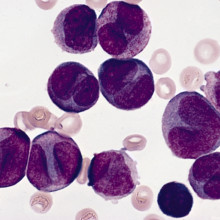
07:44 - Diabetes drugs treat leukaemia
Diabetes drugs treat leukaemia
with Mick Bhatia, McMaster University
Myeloid leukaemia is an aggressive cancer of the blood system, it prevents myeloid cells from developing into red blood cells and immune cells, leaving patients anaemic, fatigued and prone to infection. This week, scientists at McMaster University in Canada have found an innovative way to attack the cancer cells by boosting the number of fat cells in the bone marrow using a drug that is currently being used for diabetes. Leading the investigation is Mick Bhatia who explained to Michael Wheeler how they found this exciting discovery.
Mick - There were a lot of cell types in the bone marrow environment. The bone marrows environment’s made up of a lot of cells other than blood and there were particular cells types, specifically fat cells called the adipocytes, that were decreasing as the disease started to progress and became higher and higher. In cases where the chemotherapy failed, it looked like those cells were almost completely absent. Once were were convinced of that we then asked the question was there a cause and effect relationship between reduced fat and increased leukemia?
Michael - So their hypothesis was if they could boost the number of fat cells in the bone marrow that might affect the development of leukemia. They tested the idea using samples of patients’ bone marrow in a dish, but they also transplanted patients’ bone marrow cells into mice to recreate a human bone marrow environment in another living organism. The team found they were able to boost the number of fat cells in the bone marrow by administering a drug that is currently being used for diabetes…
Mick - By increasing the fat cells in that bone marrow environment it actually suppressed leukemia cells. What we didn’t count on was that, at the same time as killing the leukemia cells, it turned out we were activating the normal blood cells.
Michael - This is an exciting result as traditional chemotherapy kills both the leukemia cells and the healthy blood cells. The job of those healthy blood cells is to keep the rest of the body healthy, so losing them can be fatal. Selective impairment of just the leukemia cells seems promising... so how exactly were the leukemia cells affected?
Mick - In addition to their numbers, their general function is definitely reduced. We just don’t know mechanistically how this is happening. It wasn’t just about you have 100 cells and you went down to 50, those 50 cells that are remaining, if you waited long enough, were very debilitated, they were very weak 50 cells. They didn’t grow as fast as they normally would have, so I think it’s both the quantity and quality of those leukemic cells.
Michael - This dual effect on both the number and function of the leukemia cells should, in theory, help prevent the cancer from spreading. So were these mice cured of cancer?
Mick - We never let the experiments go to the point where we’re trying to cure the mice, we’re just looking for general effects. We have taken some mice out a little bit longer, meaning we would give them the drug for two weeks, but then we would wait longer. We do have some mice that we didn’t report in the paper that actually had no leukemia at all. Whether that is curing them of leukemia or not, we could only be speculating at this point because it’s going to be a very different scenario in patients which, I think, we’re very anxious to go to that next step.
Michael - So often, promising therapies in animal models fail to make it to the bedside of patients, so what challenges lay ahead for this discovery to make that next step?
Mick - I think the main challenges we’ll probably face will not be much different than other drugs. A drug that’s being repurposed has to be produced by a manufacturer. We have to have some sort of level of sponsorship. Getting the sponsorship, getting the funding, and then getting the organisation of all of the nurses, the physicians, clinical sites to be able to bring in the patients in and do a trial where we’ve got good numbers and we can draw conclusions.
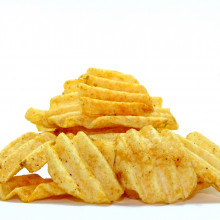
11:47 - Down to Earth: Crunch Time
Down to Earth: Crunch Time
with Stuart Higgins
This week, Dr Stuart Higgins explores how the challenge of landing a space probe has been used to keep crisps crunchy and fresh.
Stuart - What happens when the science and technology of space comes Down to Earth?
This is Down to Earth from The Naked Scientists. I’m Dr Stuart Higgins and this episode is about a somewhat unusual link between landing space probes and packaging potato crisps…
Getting into space is one challenge. Getting back down to Earth again, or say landing on another planet, is a completely different problem altogether. Take, for example, the European Space Agency’s Huygens probe. In 2005, this 318 kilogram metal box was dropped from the Cassini spacecraft into the atmosphere of Saturn’s moon Titan.
In the 2.5 hours that it took the probe to reach the surface of Titan, it had to reduce its speed from over 20,000 kilometres an hour to less than 20 as it touched down on the moon’s surface. Most of the slowing down was achieved by the probe’s giant heat shield which made up nearly a third of its total mass.
Friction with the nitrogen and methane atmosphere of Titan slowed the probe down to 1.5 times the speed of sound, around 1,850 kilometres per hour, before multiple parachutes were used to slow it down even more. This approach is similar to other spacecraft landing on Mars or Earth and when the spacecraft is carrying a precious cargo, for example humans, it’s critical to understand how it will move through an atmosphere in order to ensure it’s engineered strongly enough to withstand the tough conditions.
Engineers and scientists achieve this through a mixture of aerodynamic calculations that take into account the spacecraft’s speed, the atmosphere it’s travelling through, and the mechanical properties of the vehicle itself. They also use wind tunnels to flow air across miniature models to help better understand what will happen. Developing this expertise has huge advantages in other areas too, such as designing more efficient cars and aircraft, and also in a way you might not expect... food packaging.
It turns out that being able to predict the descent of a space probe is similar to understanding how potato crisps can be put into bags without breaking. A German company, who developed the software to simulate the movement of spacecraft through atmospheres was asked to help a food packaging manufacturer to increase the speed of putting crisps into bags. Using their space expertise, they were able to speed things up by 30 to 50% without increasing the number of breakages. They used their skills in avoiding big crunches in space to help us enjoy some rather smaller crunches… back on Earth.
That was Down to Earth from The Naked Scientists and join me again soon to learn about more space technology that’s changing lives back on Earth.
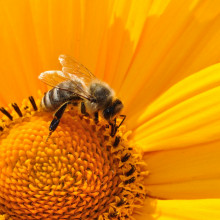
14:45 - Flowers create blue 'halo' to attract bees
Flowers create blue 'halo' to attract bees
with Beverley Glover, Director of Cambridge Botanic Gardens
Scientists at Cambridge University have discovered plants are great illusionists. Plants use a trick of the light to give their flowers a blue halo, which might make them more attractive to bees. Pollinating insects, like bees, see blue-coloured light very well, but blue pigments are very hard for plants to make, which is why blue flowers are quite rare. But rather than go to the expense of producing blue coloured chemicals in their petals, many plant species have instead evolved nano-scale wrinkles on the surfaces of their flowers. These wrinkles scatter the blue colours in sunlight, making the flower look blue - and potentially more attractive - to a bee. Beverley Glover, the director of the Botanic Gardens in Cambridge and one of the authors of the new study. Beverley explained to Georgia Mills how they discovered these "invisible" blue halos.
Beverley - They’re not always invisible to us. If the pigment that the flower has underneath the blue halo is a dark purply black colour, we can sometimes get a hint of it and it was looking at a flower like that that first gave us the clue. Then we worked out how to measure the blue halo, so you can record this scattered light in the blue and ultraviolet coming off the flower of a quite wide angular range. Then we used the collection of plants at the Cambridge Botanic Gardens and just waded our way through them measuring flowers that we thought looked possible and had the right sort of ridges on their surface. And discovered that, actually, a surprising number and quite widely dispersed across the flowering plant family tree are doing the same trick.
Georgia - How do we know this is to attract the bees?
Beverley - We don’t know yet that that’s what it is for, but it’s an obvious hypothesis, an obvious idea because that’s what flowers are all about. They’re all about attracting animals to pollinate them, and the petals particularly are really just there as an advertising too. So we did some experiments where we made artificial surfaces that could make the same blue halo, and we asked bumble bees in our lab setup whether they could see the blue halo even if we couldn’t, and they certainly could. Then we just used that flowers and asked how long it took them to find them? And we found that having the blue halo made the flowers stand out much more to the bees and they were much quicker finding them. So that all adds up to the idea that probably they’re involved in attracting the bees, but we’d like to get out there in the wild and test that there too.
Georgia - The blue makes it more easy for the bee to find it, which helps them when they’re foraging, and then helps the flower because they’re more likely to get pollinated?
Beverley - Exactly. Flying bees are having quite a hard time energetically and anything that makes it easier for them to find flowers, get hold of the sugar quickly, and move on to the next one has to be a good thing. And of course, anything that’s a good thing for the bee and is going to make the flower more attractive, is food for the lower too.
Georgia - You mentioned this trait was found in quite a lot of plant species. Is it that one plant had this great idea many years ago and they all evolved from it?
Beverley - No, so that was the surprising thing. When I say quite a lot, it's not very common, most flowers don’t have it. There are, obviously, hundreds of thousands of flowering plant species, but what we found was that there are flowers in all of the major groups of the flowering plant family that have it widely dispersed families. What that tells us is that it probably evolved convergently multiple times. It’s not there is the oldest flowering plants that we still have alive today, but it’s there is scattered species in all the other groups, so we think it’s probably repeatedly or convergently evolving.
Georgia - Wow. So all of these different lines of plants have separately worked out, I guess, this trick to make themselves look blue when they’re not actually blue?
Beverley - Yeah. And I think that’s probably not surprising because they really have to do is work out how to produce a ridged effect on their surface out of their cuticle. All plants have a cuticle that protects them from drying out and so probably it’s not that surprising that more than one plant’s come up with the idea of folding that cuticle up if that give you a really good blue effect.
Georgia - If quite a lot of them have managed to do it and it’s supposedly an advantage, why do we think they all don’t do it?
Beverley - Well, that’s one of the great mysteries of evolution, isn’t it? I could really use wings some days. I think about flowers as all trying to stand out against a green background. They’re all shouting at the pollinators ‘look at me, I’m over here, come and pollinate me,’ and there are hundreds of thousands of different ways of doing that. You can do it by being blue, or being sparkly, or by being yellow, or by having patterns on you, by smelling nice, and I guess some of them have come up with the blue halo idea, but others have got other ideas too.
Georgia - Is it really that hard to make blue pigment that the plants have had to invent this other way of looking blue?
Beverley - Yes, it really is. It’s surprising isn’t it? If you think about cut flowers that you might buy for the house or garden flowers, it’s very hard to get a true blue. You come up with something like cornflower or Himalayan mountain poppy, they’re aren’t many species that do it. And that’s because the main pigment that plants use for colour is a molecule of anthocyanin, and anthocyanin comes in a sort of red, pink, purple range.
To make it look blue, you first of all have to add extra hydroxyl groups to the molecule and not many plants have the right enzyme to do that, and even then gives you a kind of purply colour. To make it properly blue, you need to put it at an alkaline ph, so you need to change the ph of the vacuole in the cell where the pigments sitting to get that true blue effect, and that’s really difficult to do. That involves pumping ions across the cell membrane and not many plants have come up with the ability to do it which, of course, is why you can’t blue blue roses in the garden centre.
Georgia - Of course, unless they’re ones that have been dyed.
Beverley - Absolutely.
Georgia - So what’s next; are you going to try and find out if it really does confer this advantage in the wild?
Beverley - We’d like to do that. But to do that I need a line of flowers that doesn’t make it, that’s otherwise identical to a line of flowers that does make it. I don’t want to compare two different species, one with and one without, because that’ll have lots of other confounding effects involved. So, we’re working on, at the moment, the really exciting question of how you develop this structure? How the flower manages to control the patterning of it’s surface cuticle in a way that you get these ridges, and you get this colour effect? And, of course, in the process of working that out we’re likely to generate mutants that don’t do it because we’re using a genetic approach. So once we’ve got a nice mutant that doesn’t do it then certainly, we’ll be out there in the field seeing what happens.

20:52 - UK Great Tit: Why the long beak?
UK Great Tit: Why the long beak?
with Lewis Spurgin, University of East Anglia
We’ve talked about the bees, now it’s time for the birds! Scientists across Europe have been studying the evolution of the Great Tit for decades. Over time, animals evolve to have features that are most suited to their environment which, in turn, make them more likely to survive and reproduce. This process is known as natural selection, and it’s happening in your back garden! Researchers have found that UK Great Tits have evolved to have longer beaks than their European relatives. How? Well, we Brits are rather fond bird feeders and so the Great Tits have evolved to have longer beaks to get their grub. Izzie Clarke spoke to Lewis Spurgin from the University of East Anglia about what these birds look like...
Lewis - The Great Tit’s a small, colourful bird that you’re very likely to see in your garden. It’s found all across Europe and scientists in Oxford, and the Netherlands, and other places have been studying the biology and ecology of the species for decades. We didn’t just want to look at how natural selection works at the DNA level, we wanted to do that and link the genetic differences that we saw to actual physical differences among individuals and populations.
Izzie - What exactly did you find?
Lewis - In a nutshell, we were able to show using DNA that there’s been really recent and rapid selection for longer beaks specifically in British Great Tits. We showed that if you were a British Great Tit, and you’ve got gene variants that code for a longer beak, you’re likely to fledge more offspring. And we found this intriguing correlation between beak length in the UK and how often birds visit bird feeders. So this led us to speculate the widespread use of bird feeders in the UK might have resulted in natural selection for the longer beaks we see in British Great Tits compared to their counterparts in mainland Europe.
Izzie - So the British Great Tits are a little bit more greedy, shall we say?
Lewis - Yeah, that’s possible.
Izzie - How exactly do you go about collecting all of this information from the UK Great Tits compared to these ones in the Netherlands?
Lewis - We start off by catching birds and taking a small sample, either from a feather or a small blood sample which doesn’t harm them, and from that we can extract their DNA. Using that we can use statistics to compare the DNA of the UK and the Dutch populations and we can look for genes that are involved in natural selection.
The most significant one that we found was a gene called COL 405, which is a gene that produces collagen. And then what we can do is look at what these genes do in order to say something about how selection produces differences among individuals and populations. Using that approach, we found that the genes under natural selection between our UK and our Dutch Great Tits were involved in controlling face shape.
We also find evidence of one of the genes that is also associated with beak shape variation in Darwin’s finches. So this was what led us to think that perhaps these genes might be involved in controlling beak variation in birds and, when we looked at that statistically, we showed that that was the case.
Izzie - Over what period are we talking about because we have this idea that natural selection in evolution takes quite a long time, so how long has this process been going on?
Lewis - Natural selection can take quite a long time, but it can also be quite rapid. We actually have a long term study of Great Tits in Wytham Woods, so run by Oxford University, and they’ve been measuring beaks in Great Tits for a really long time in Wytham Woods. If we take Great Tits from the 1970s through to today, over that period of time we can measure an observable increase in beak length, but probably this has been over the last couple of hundred years or so this natural selection. So that’s one of the striking things about the study is that it’s an example of really quite rapid and recent natural selection.
Izzie - What does this tell us to have this longer beak for these UK Great Tits?
Lewis - In the sense that with the birds that have longer beaks, or at least the birds the genetic variation for longer beaks, are able to fledge more offspring. So in that sense, if you are able to fledge more offspring, then more of your genetic descendants can be recruited into the breeding population and you’re going to evolutionarily be more successful. Even small differences in your survival or reproduction can make a big effect overall on variation in a population.
I think what we really need to get at next is what exactly is the cause, and so I think we’d like to follow up on this bird feeder link and think about what, how, and where might bird feeders be driving differences between British and mainland European populations? Does this occur in other species and what are the consequences of removing that selection pressure and mechanistically how does that work? There’s lots of interesting things that we can look into there.
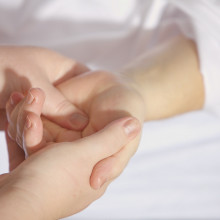
26:15 - Skin 101: What is skin?
Skin 101: What is skin?
with Dr Jane Sterling, Addenbrookes Hospital
Skin is our largest organ, but what exactly is it? Dr Jane Sterling, from Addenbrookes hospital in Cambridge joined Graihagh Jackson in the studio.
Jane - Skin is a wonderful part of the body that works 24/7 to keep us together and working well. It’s a multi-layered surface, so there’s an outside layer - the epidermis - that keeps changing every day; it keeps renewing itself. And then below that is the dermis which gives the skin stretch and strength, and that enables us to move around without the skin splitting every time we bend an elbow or kneel down.
Graihagh - There’s a layer below that as well, isn’t there?
Jane - Yes. There’s the subcutis and that is where the fat is found. So, if you put on a bit of weight and gain some fat, that all sits down in the subcutis and gives the skin extra padding and softness.
Graihagh - I’m sure, which we’re all conscious us as it’s coming through to winter. If I got a cut or something on my hand, how exactly does the skin grow and repair itself?
Jane - Well, it starts immediately. If you cut yourself with a knife, for instance, what you’ll see, of course, is bleeding and that then clots and solidifies and, as soon as that happens, the skin is activated to start repairing itself. New cells come in and start to repair the base of that cut and gradually, over time, strength comes to it and then finally the epidermis comes over after a few days and kind of seals the gap.
But if you have a deep cut like after an operation scar, then that takes a few weeks to a couple of months to regain its full strength. And that’s why they always tell you not to do anything too vigorous after you’ve had an operation so you don’t stretch the scar.
Graihagh - Skin is regenerating all the time isn’t it - it’s not just when you have a cut or anything?
Jane - No. The surface of the skin’s always peeling off. If you get sunburn or something like that you do see the skin peeling off, but all the time we’re losing cells from the surface of the skin. In fact, most of the dust in the house where we live is made up of skin cells that have dropped off our surface and have just accumulated in the corners.
But it’s a very good system because, obviously, we’re rubbing into things and clothes rub the surface of our skin gradually, so the fact that it can repair itself from below is essential otherwise we’d just all be worn away.
Graihagh - How quickly does that regeneration or that process take?
Jane - It’s thought that new skin cells that are made only just a millimetre below the surface that’s at the base of the epidermis, they take about a month to go from the base of the epidermis up to the surface. If you’re younger they move a bit quicker and, like everything else, when you're older they move a bit slower.
Graihagh - I’m thinking of common skin conditions - psoriasis is one that comes to mind. How does that compare to someone, when we’re talking about regeneration, who doesn’t have it?
Jane - Yes. Psoriasis is a fairly common skin disorder and usually seen with red flakey patches, particularly on the knees and elbows and in those patches, the skin is turning over much quicker. The epidermis is turning over quicker, so it takes just about a week for the whole epidermis in those affected areas to renew itself. Of course, if skin’s turning over quicker, it doesn’t make itself quite so perfectly and that’s why the surface is much more obviously flakey and pulls away from the skin quicker.
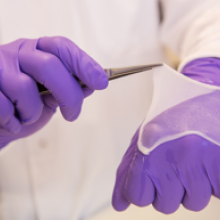
29:56 - New method to treat burn patients
New method to treat burn patients
with Dr Stuart Brown, Restoration of Appearance and Function Trust
One thing that has been hitting the headlines in recent months is the rise of acid attacks, where corrosive substances have been thrown at people, causing severe damage to the skin and scarring. Dr Stuart Brown is a Scientist from The Restoration of Appearance and Function Trust, and joins us now. He’s part of a team that has developed a new material that could change how we treat acid attack and burn patients. Georgia - What happens to the skin if it has suffered a burn? Stuart - Where you’ve got a burn or an acid attack, you’ve really got a very serious injury to the skin. Often it’s very deep into the dermis and those sorts of things don’t heal very well on there own so you need to have surgical intervention. But you’ve got a problem where you’ve got a massive fused sort of glob of protein that the body doesn’t know to break down or get rid of, so the surgeon has to come along to take that off in order to let a normal healing process go ahead. Georgia - Burns can be extremely devastating so what is the current method to treat them? Stuart - The reconstructive surgery would really use skin grafts often. When you look at an acid attack it’s obviously on exposed areas of the skin, so it’s very important to have a good functional outcome where the skin is flexible and has the best appearance that you can as well. The skin graft is the normal way that they go, which is the best current technology but can definitely be improved upon. Georgia - Is that where you take skin from one part of the body and then move it? Stuart - From the same patient, yeah. So you're essentially displacing the wound to an area where you think will heal better and you're trying to give the original wound basically a new patch in a way. Georgia - Wow. So it’s quite a considerable treatment then. What have you come up with then that’s different? Stuart - Not just me alone, but it’s been in development for about ten years. We’ve come up with a product called SmartMatrix, and it’s basically a dermal scaffold. It’s a product which is like a structure for the skin to have a normal wound healing process upon. We’ve developed it with the aim of having the best function and esthetic appearance at the end. We’re quite excited about it because we think it will be able to take away the graft that is the current practice and actually just do better than the graft in a way. Georgia - Okay. So it’s a scaffolding - I’m guessing a very small scaffolding - that goes upon the affected area? Stuart - It’s almost like a sponge. It’s got a very specific composition and it’s got a very specific structure, and both of those things are very important for the way that the body reacts to it. It’s actually made from fibrin, which is a product that’s created from fibrinogen. When you get cut, as you were saying earlier, and you blood stops and it stops because a fibrin plug is created from fibrinogen in the blood, which just floats around in your body all the time. This fibrin plug has got a very different sort of structure to what we’ve done, so we’ve taken that fibrin plug and sort of spread it out and put lots of little holes in it. What that lets us do is it lets things colonise that a lot better so the wound healing response can go a bit better. It’s much better at getting a blood supply and that’s absolutely critical for a good wound healing outcome. Georgia - I can see you’ve got a packet of it - it’s called SmartMatrix - on the table here, so let’s have a look. We’ve got some here and looks like candy floss that’s been flattened I suppose. Stuart - It’s a very porous material. There’s very little protein - a lot of air there. We want something very light that the body will embrace quite well, and that it can send cells through very well. That’s part of the thing, you can put it in the wound and it will break down and disappear. You don’t have to go back in and take it out. As it breaks down it send out information, it sends out a signal to attract the blood supply as well, so we can have cells growing into it. It will send out signals to encourage the blood supply and we can the best wound healing outcome that we can. Georgia - Oh, wow. And we heard earlier that these acid attacks and burns are obviously massive problems for people, so how far are we along in this getting out to people? Stuart - We’ve been through one clinical trial and we’re doing another one next year, and the one next year we’re doing without the graft. We think within a couple of years it could be in the hands of surgeons, and it should give them a wider repertoire to pick up for more treatments that would then be suitable for these very challenging wounds like acid attacks. Georgia - Right. You mentioned earlier that skin grafts they need to take skin from another part of the already probably quite traumatised person and move it around. Are there any other benefits to using this new method? Stuart - It really comes down to skin grafts themselves. There are certain bad things associated with them. It’s just really the contraction and the risk of them failing as well. This can’t fail because it’s human protein and the body does not react to it in the way that it reacts to a graft that’s failing. Georgia - Have we seen any side effects from the fibrin as it breaks down in the body? Stuart - No, nothing. No, it’s been fine.
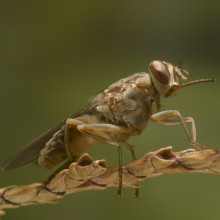
34:34 - Parasites: Getting under the skin
Parasites: Getting under the skin
with Annette Macleod, University of Glasgow
Now our skin is an important barrier against infections, but there are also lots of microbes that make their home there. While most of this is harmless or useful, sometimes something unexpected can hide away there. Sleeping sickness is a disease that affects sixty million people in rural parts of East, West and Central Africa. It’s caused by parasites that get into your skin and blood system. If left untreated, Sleeping Sickness severely damages the nervous system and can be fatal. Efforts to eliminate it haven't been going as well as hoped, but could it be because we’ve been ignoring the skin’s important role in the transmission? Izzie Clarke spoke to Annette Macleod from the University of Glasgow who’s working to improve the diagnosis technique.
Annette - The disease is transmitted by the tsetse fly. When the tsetse fly comes to take a blood meal it bites your skin, they make a bit of a mess of the skin. They suck on the pool of blood and lymph that collect at the bite site, and that’s when they inject the parasites, and that’s how you get infected.
Izzie - How is this normally diagnosed?
Annette - Up until very recently it wa always thought that sleeping sickness was a blood disease, and you would diagnose that by looking in people’s blood. But what we have discovered is that the parasites are also in the skin and, in fact, some people don’t have any parasites in their blood, or very few, so you cannot detect them, but they can have quite a lot of parasites in their skin. So these individuals are not diagnosed, but the could contribute to transmission when a tsetse fly comes to bite you.
Izzie - If these parasites are residing in the skin so a blood test may not actually be the best way forward - is that right?
Beverley - That’s right. There’s a significant proportion of people that have antibodies to the parasites, but we couldn’t find any parasites in their blood. These individuals were not treated and kind of ignored. But we believe now that these individuals have got an infection and they are important in terms of disease transmission. They could actually be hindering the WHOs programme to eliminate the disease because if you have people that are transmitting the disease but seem to be relatively healthy, they can keep spreading the disease and it’s very difficult then to eliminate it. What we want to do is identify these individuals so we can treat them and then, hopefully, eliminate the disease that way.
Izzie - If we can’t use blood tests to find out who’s been infected by these parasites, how can we get around that problem?
Beverley - We’ve been trying to develop with our collaborators from Strathclyde University, Duncan Graham, to develop a non-invasive handheld tool that will detect the trypanosomes under the skin. This is based on raman technology so, basically, you shine a laser on somebody's skin and you can hopefully detect a parasite that are under there. You can see a difference in the raman signal that you get from infected skin versus uninfected skin, and trypanosomes have a unique signal so we can focus in on that signal and say oh yes, this person’s infected.
So that’s the idea and that’s what we’re trying to develop, and we tested a prototype of this in New Guinea a couple of months ago, and it’s by no means perfect but it’s very promising. I think we can develop it further.
Izzie - Is there any way that once you’ve found out that there is this infection that it can be treated?
Beverley - Yes. You can treat the disease with drugs that are free from the WHO, but you have to be hospitalised for about two weeks, and that’s part of the reason why people with latent infection are not generally treated. You only treat people that you have seen parasites in the blood - that is the current WHO standard.
Izzie - Why is it important to investigate this so thoroughly?
Beverley - It’s holding up the elimination programme. What’s happened previously is that the number of cases of sleeping sickness had come right down in the 1960s, and then we took our eye of the ball and then the disease re-emerged. We got lots of cases, up to 300,000 cases in the 1980s. So now we’re back getting the disease under control but we have to understand how the disease re-emerges. We think it’s these individuals that don’t have symptoms but they’re carrying the disease and they are seeding the next epidemic, so we need to stamp that out.
Izzie - How long can this last in the system?
Beverley - We were involved in this very interesting case of somebody who’s from Africa, from Sierra Leone, and he came to this country 29 years ago, and then came down with sleeping sickness. So he was fine for 29 years, and then he was treated with immunosuppressants for an unrelated disease and he came down with sleeping sickness. He was able to control the disease for all that time.
Izzie - If you are able to improve this method, can it be used for anything else?
Beverley - Yes. This technology has been used to identify skin cancer, for example. Even to detect fake whiskey in whisky bottles, so it’s got lots of applications. When you go to the airport and they scan your bag with a little cloth and then put it in the machine, that’s raman that they’re detecting to see if you’ve got cocaine or explosives. But we can also use this technology to look at other vector-borne diseases that have the same component like Onchocerciasis, for example, where we know the parasites are in the skin, so I think it’s got lots of potential.

A History of Tattoos
with Dr Matt Lodder, University of Essex
We couldn’t talk about skin without mentioning an ancient practice that is still very much popular today. The art of Tattoos. Like them, or loathe them, we’ve been using our skin as a canvas for thousands of years. Tattoo Art Historian, Dr Matt Lodder, from the University of Essex explained the tattoo process to Georgia Mills...
Matt - The biomechanics of tattooing is quite straightforward. It’s simply the insertion of ink particles into the dermal layer of your skin - you heard about that earlier on. It’s essentially an immune response, as your body’s trying to remove this strange foreign body. It send cells called macrophage which try and remove the particles but the particles are too big for the immune system to remove, so they just sit there encompassed in this immune cell and it doesn’t go anywhere for the rest of your life.
Georgia - I suppose they’re deep down enough that the layer isn’t shed off?
Matt - Absolutely. There is a bit of movement over your life but not a huge amount.
Georgia - Yeah. You see sometimes that they get a bit stretchy.
Matt - Yeah, and a bit blurred.
Georgia - I was surprised this isn’t a modern practice, this has been going on for a long time. So what’s the oldest evidence that we have of a tattoo?
Matt - We can infer tattooing through things like anthropomorphic sculpture back to the Neolithic. But the earliest evidence we have of an actual piece of preserved tattooed skin was dug up in the Austro-Italian alps in the early 90s and it dates back to about 5½ thousand years ago, so 3½ thousand years BC. Essentially we think tattooing is about as old as humanity but 3½ thousand years before the common era is about as old we can go.
Georgia - I’m trying to imagine what a tattoo from 5 thousand years ago would look like. What was it?
Matt - This specimen is called Otzi - Otzi the Iceman - he’s got kind of little crosses and tally marks on various sites of his body: on his ankles, his knees, his wrists, and his stomach. It’s thought, although we can’t prove this, it’s inferred that they’re some kind of magical or medicinal because the tattoos are found on sites where there are signs of things like arthritis and other kinds of injury. So perhaps they were magical or intended as medicinal in some way.
Georgia - Oh, right. And I suppose looking back through history do tattoos always seem to fulfil the same roles - are all cultures using them?
Matt - We find tattooing or other forms of skin marking in pretty much every culture we’ve ever encountered but the uses vary. Often they’re decorative, sometimes they’re symbolic and ritual, other times perhaps they’re magical or intended for some medicinal purpose.
Georgia - How were these tattoos being done all this time ago - do we know?
Matt - For Otzi we don’t know, but to make a tattoo you just really need a sharp stick and some ink, or a sharp needle of some kind. We find the very basic poking type of tattoo across the world and that’s a needle made from bone or from literally sharpened sticks. In some cultures you find really interesting practices, so Inuit tattooing in North America, for example, tattooing was made by sewing sinew of Cariboo coated in ink through the skin, which produces a particular dot/dash kind of pattern.
Georgia - Oww! People really suffer for their art then?
Matt - Yeah, absolutely. I don’t think it was very pleasant.
Georgia - The modern technique, it’s thankfully not being sewed through with Cariboo?
Matt - No.
Georgia - So how did that get developed?
Matt - You can still get that done. There are still friends of mine who still do that on people if you want that. But the modern tattoo machine is an invention of the Victorian era really. It comes with the era of the novel electric device. In fact, the first ever handheld electric device, which was a machine for filling dental cavities, and very, very quickly got turned into a tattoo machine in the 1880s and 90s
Georgia - Looking back through history, what’s your favourite example of tattoo use - how people are using tattoos on their bodies?
Matt - I’m an art historian, so I like seeing things people are copying. In the Victorian era, which I’m really enamoured with, you find people getting these amazing, beautiful copies of their favourite paintings. Huge back pieces done over the course of several days. It probably also wouldn’t have been very pleasant, but the tattooist in the Victorian period used to inject cocaine as an anaesthetic.
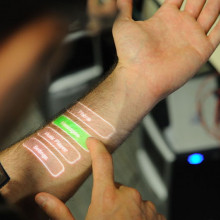
44:55 - E-Skin: The future of wearable technology
E-Skin: The future of wearable technology
with Zhenan Bao, Stanford University
What will tattoos look like in the future? Worldwide, teams are developing electronic skin and e-tattoos, these are flexible materials can sit on our skin and keep an eye on our health, as Georgia Mills and Graihagh Jackson found out. Zhenan Bao from Stanford University is an expert in the field…
Zhenan - What we’re trying to do is to make the future of wearable electronics. The future of wearables are going to be soft, stretchable, and bendable like our skin. It can look like a tattoo that could be temporary and they can sense different parameters: from blood pressure, heart rate, to temperature or, in the future, even chemical signals.
Georgia - Picture a rub-on tattoo with tiny patches of electronics - an e-tattoo if you will. You could place it on your body and directly measure what’s going on in there: your blood pressure, your temperature, heart rate, or even get a peek at your immune system…
Zhenan - The combination of information can be used to potentially predict the onset of certain diseases. For example, one of my colleagues at Stanford did a study; he was able to predict the onset of flu even before the patient started to feel the symptoms of flu.
Georgia - Pretty handy! And in the future, soft electronics could even be placed under our skin giving the sensor more access to information linked to our hormones, which could help monitor depression or things like blood sugar levels. And getting a little bit ‘big brother,’ some companies have even planted these chips under their employees’ skin to act as access cards and open doors. But skin, unlike most electronic equipment, is stretchy, so for e-tattoos to work they need to be built a little bit differently…
Zhenan - We use soft plastic material and, through molecular engineering, we make such plastic into electronic materials so that they not only can conduct electricity but also, at the same time, they're as soft as our skin and potentially can even self-heal as our skin.
Georgia - Zhenan is even exploring the possibility of creating flexible batteries to match these stretchy electronic circuits. But there are still a few different challenges to overcome…
Zhenan - The tattoos or the patches will transmit information wirelessly. We need to make sure they are secure so that the information about the person will not be hacked. In that case, the patient needs to be able to control who can view the information and who they want to share the information with. In order for e-skin to be widely spread, we need to address both technological issues and security issues.
Georgia - Zhenan Bao there - Graihagh what do you think, would you get an e-tattoo?
Graihagh - I kind of like the idea of being able to predict the onset of flu and I could even, although it’s slightly like a dog being chipped or something, but I could even get on board with that if I could get on the train and tap in rather than buy a ticket. It was only when Zhenan said about wirelessly transmitting data that I suddenly thought “hang on a minute here, I’m not entirely convinced I want someone to know my movements throughout my Saturday or any day, actually, for that matter.”
Georgia - But especially Saturdays?
Graihagh - But especially Saturday. Who knows what I get up to!
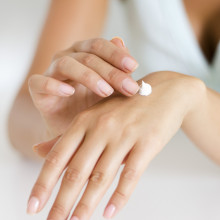
48:51 - How can we protect skin?
How can we protect skin?
with Dr Jane Sterling, Addenbrookes Hospital
Skin acts as a barrier to protect us, but what can we do to keep it healthy? Georgia Mills spoke to dermatologist, Dr Jane Sterling. Jane - Well, the skin itself does a pretty good job of keeping itself healthy, so we don’t need to do too much. We need to just make sure that we’re keeping ourselves fresh and clean. I guess by washing, but that is something we tend to do a bit too much of in modern society. Overwashing, or too much detergent, or too much exfoliation can, in some ways, be bad for the skin. And it is important as you get older to use a little bit more moisturiser because our grease glands stop working as we get older. So those two things are important and, in the long term, best not to have too much sun. Georgia - Right. Because I know moisturisers one of those things that’s a multi-million dollar industry and you wonder is the science behind it legitimate? Jane - Of course, very expensive skin creams contain all sorts of wonderful ingredients. However, probably the most important ingredient is some sort of oily, greasy thing that will actually just produce some barrier function on the skin. Georgia - I recently tried a facemask that made me look like a ghost - it was like ectoplasm. Jane - It sounds like a perfect one for Halloween. Georgia - Yes, exactly. It’s got a use then. How about the food we eat, is there something we can do in our diet? Jane - Probably, as long as we eat a well-balanced diet, nothing special. Certainly, if you’re low on various vitamins it can make your skin look not so healthy or doesn’t heal so well. But a well-balanced diet with vitamins and minerals is all we need.
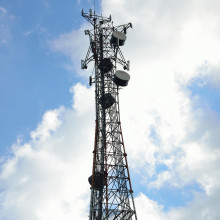
50:29 - Are phone towers harmful?
Are phone towers harmful?
Stevie Bain has dialed into this question from Jayson, with help from Professor Tony Kent from the University of Nottingham...
Evan - "Our new house is 140 metres from a cellphone tower. As a family, the three of us feel like we have been affected to different degrees in terms of sleep, motivation, and anxiety which are common reported symptoms of exposure to microwave radiation. It’s a controversial topic but are there any major health risks with living close to a phone tower?"
Stevie - Smartphone technology has transformed our lives in so many ways. But, with the proliferation of base stations to serve our ever-increasing hunger for data, there have been understandable concerns over the safety of exposure to microwave radiation. So should we be concerned? We put the question to our listeners on the forum.
Evan thinks that ironically there are fewer risks living closer to a tower because the antenna are mounted on a high point and emit radiation horizontally. Syhprum points out the more practical dangers saying the only danger warning he has seen on a tower said “don’t stand too close in winter as large icicles fall off.”
But what do the experts think? We asked Tony Kent, Professor of Physics at the University of Nottingham to shed some light on the situation.
Tony - although the word “radiation” is common, there are different types of radiation that affect the body in different ways; examples being microwaves and nuclear radiation. The main hazard for microwave radiation, the kind that is emitted from phones and base stations, is heating due to the microwave shaking the molecules, which is put to good use in a microwave oven. The International Commision on Non-ionising Radiation Protection put an upper limit of 80 milliwatts on the amount of microwave radiation per kilogram that a member of the public should be exposed to; known as the Specific Absorption Rate (SAR), which includes a safety margin of error.
Stevie - So how exactly does the level of radiation in our microwave ovens compare to those emitted from a phone tower?
Tony - If you could squeeze yourself into a microwave oven, close the door and turn it on from the inside, you will absorb about one kilowatt of microwave radiation, which is about 200 times greater than the SAR and, not surprisingly, you would cook yourself slowly. The mobile phone mast radiates typically a 100 watts. This is emitted in all directions horizontally and hits the ground about 50 metres from the mast. The exact amount of radiation you would intercept at a distance of 140 metres from the mast depends on the details of the antenna radiation pattern. But a worst case estimate would be about 100 microwatts per kilogram, well below the SAR limit and, actually, much less than from using your own phone, which is also well below the SAR.
Stevie - Thanks Tony for tapping into that topic. Next week we’re summoning a solution to this spooky Halloween headscratcher…
In the 1940s there was a chicken that survived 18 months without a head. How long could a human survive without a head?










Comments
Add a comment